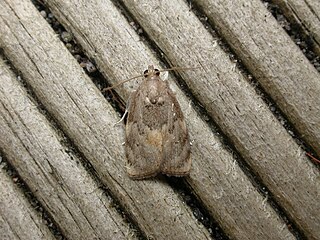
Imma is a large genus of moths in the obtectomeran "micromoth" family Immidae. This is the type genus of its family. They are widespread in the tropics, with most species occurring between the Himalayas and the Oceanian region; the genus is furthermore plentiful in the Neotropics, but not very diverse in the Afrotropics.
Imma acroptila is a moth in the family Immidae. It was described by Edward Meyrick in 1906. It is found in Sierra Leone.
Imma cancanopis is a moth in the family Immidae. It was described by Edward Meyrick in 1906. It is found in Colombia and French Guiana.
Imma chasmatica is a moth in the family Immidae. It was described by Edward Meyrick in 1906. It is found in the Indian states of Sikkim and Assam.
Imma cladophragma is a moth in the family Immidae. It was described by Edward Meyrick in 1906. It is found in Singapore.
Imma epicomia is a moth in the family Immidae. It was described by Edward Meyrick in 1906. It is found on the Solomon Islands.
Imma metachlora is a moth in the family Immidae. It was described by Edward Meyrick in 1906. It is found in Brazil.
Imma nephallactis is a moth in the family Immidae. It was described by Edward Meyrick in 1906. It is found in Venezuela.
Imma procrossa is a moth in the family Immidae. It was described by Edward Meyrick in 1906. It is found on Borneo.
Imma triardis is a moth in the family Immidae. It was described by Edward Meyrick in 1906. It is found in southern India.
Imma lyrifera is a moth in the family Immidae. It was described by Edward Meyrick in 1910. It is found on New Guinea and Australia, where it has been recorded from Queensland.
Imma periploca is a moth in the family Immidae. It was described by Edward Meyrick in 1910. It is found on New Guinea.
Imma phthorosema is a moth in the family Immidae. It was described by Edward Meyrick in 1912. It is found in Colombia.
Imma halonitis is a moth in the family Immidae. It was described by Edward Meyrick in 1920. It is found in Chennai, India.

Imma acosma is a moth in the family Immidae. It was described by Alfred Jefferis Turner in 1900. It is found in Australia, where it has been recorded from Queensland and New South Wales.
Imma albifasciella is a moth in the family Immidae. It was described by Arnold Pagenstecher in 1900. It is found on the Bismarck Archipelago and in Australia, where it has been recorded from Queensland.
Imma hemixanthella is a moth in the family Immidae. It was described by William Jacob Holland in 1900. It is found on Buru in Indonesia.
Imma platyxantha is a moth in the family Immidae. It was described by Alfred Jefferis Turner in 1913. It is found in Australia, where it has been recorded from Queensland.
Moca radiata is a moth in the family Immidae. It was described by Thomas de Grey in 1897. It is found in the Democratic Republic of the Congo and Gabon.
Imma nephelatma is a moth in the family Immidae. It was described by Edward Meyrick in 1927. It is found in New Guinea.
